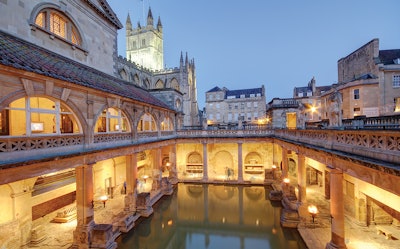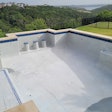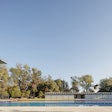
The evidence was always staring us in the face. Roman concrete is much more durable than modern concrete. Anyone with eyes could figure that out.
If you go anywhere within the ancient Roman world, from Bath in the UK, to Ephesus in Turkey or to Rome itself, you will see concrete structures, even those in aquatic environments, such as docks, sewers, public baths and aqueducts, that have stood up under the ravages of time and nature, from earthquakes to the relentless corrosive effects of water itself.
When you look up at the Pantheon dome, the concrete looks just as solid and unmarred as the day it was made almost 2,000 years ago. The forming details are completely intact. And there are Roman aqueducts still in operation today, still delivering water for use, after all this time.
For centuries, this has been obvious to everyone — the dramatic difference between the lifespan of Roman and modern concrete. Today, we renovate and resurface to keep our concrete structures in order, but even then they break down relatively quickly. Long before a millennium has passed, or even a century, or even a few decades, you're looking at cracks and rusty rebar peeking through, and it's time for demolition.
Long before I knew anything about pools or construction, as I gazed at the still-clear inscriptions on the side of the Colosseum, I wondered about this. At that time, and for much of modern history, the scientific explanation has been a secret ingredient that the Romans used called pozzolanic ash. Pozzolonic ash is a volcanic material that comes from Pozzuoli, not far from the ancient city of Pompeii. It was shipped throughout the Roman world as a key ingredient in concrete.
Researchers looking at ancient Roman concrete under a microscope also noticed tiny, white mineral features within the structure. These features, found in all samples of ancient Roman concrete but not in modern concrete, are called "lime clasts," and form at very high temperatures during the mixing process. These lime clasts, made of calcium carbonate, were dismissed as evidence of poor mixing practice.
(Yes, it is odd that "poor practice" was used as an explanation for a feature in superior concrete. Sometimes only hindsight allows us to see things clearly.)
 Public pool built by the Romans at Bath, UK, in the first century AD, using a combination of concrete and stone. Still looking good.
Public pool built by the Romans at Bath, UK, in the first century AD, using a combination of concrete and stone. Still looking good.
Anyway, this was the status of modern scientific thought on Roman concrete until January of this year when a team of investigators from MIT, Harvard and Swiss and Italian laboratories published findings that stood conventional scientific wisdom on its head.
"The idea that the presence of these lime clasts was simply attributed to low-quality control always bothered me," says study author and MIT professor of civil and environmental engineering Admir Masic, in a story published in MIT News. "If the Romans put so much effort into making an outstanding construction material, following all of the detailed recipes that had been optimized over the course of many centuries, why would they put so little effort into ensuring the production of a well-mixed final product?"
As the MIT researchers focused on the lime clasts, they began to discover they were not mistakes at all but were more likely key structural formations in Roman concrete, providing its unique self-healing properties. As tiny cracks form in Roman concrete (as they do in all concrete), they prefer to move through the lime clasts, which dissolve, react with water and then recrystallize as calcium carbonate, self-sealing the crack. In essence, Roman concrete has been repairing itself automatically for 20 centuries.
The Romans were using quicklime in their mix, a highly reactive form of lime, which produces a strong chemical reaction that heats up the mix to very high temperatures. This hot mix resulted in the formation of the lime clasts that are now seen to be the key to the Romans' super-durable concrete. As all modern builders know, this would dramatically increase the required speed of the building process because the hotter the mix, the faster it sets and cures.
 Roman aqueducts, like this one in France, were built using concrete, stone and brick. Water was propelled for many miles by gravity down a slope of about 1 foot per mile.
Roman aqueducts, like this one in France, were built using concrete, stone and brick. Water was propelled for many miles by gravity down a slope of about 1 foot per mile.
HOT MIX
"The benefits of hot mixing are twofold," Masic told MIT News. "First, when the overall concrete is heated to high temperatures, it allows chemistries that are not possible if you only used slaked lime, producing high-temperature- associated compounds that would not otherwise form. Second, this increased temperature significantly reduces curing and setting times since all the reactions are accelerated, allowing for much faster construction."
To test their findings, the researchers in the study mixed up samples of concrete using the ancient Roman hot-mix method and typical modern methods, and bingo, the Roman concrete cracks self-healed in the same way as predicted and previously described, while the modern concrete cracks just sat there.
This has the researchers dreaming about the possibilities.
"It's exciting to think about how these more durable concrete formulations could expand not only the service life of these materials, but also how it could improve the durability of 3D-printed concrete formulations," Masic says.
The brilliant international research team, which solved a mystery that had puzzled millions of people for centuries, deserves full accounting. It included Janille Maragh at MIT, Paolo Sabatini at DMAT in Italy, Michel Di Tommaso at the Instituto Meccanica dei Materiali in Switzerland, and James Weaver at the Wyss Institute for Biologically Inspired Engineering at Harvard University. The work was carried out with the assistance of the Archeological Museum of Priverno in Italy.
This article first appeared in the March 2023 issue of AQUA Magazine — the top resource for retailers, builders and service pros in the pool and spa industry. Subscriptions to the print magazine are free to all industry professionals. Click here to subscribe.












































